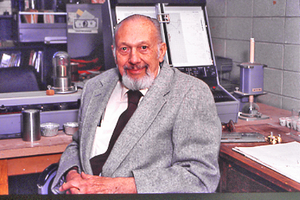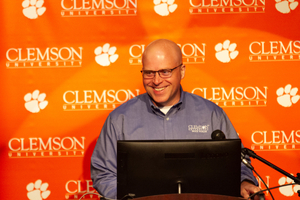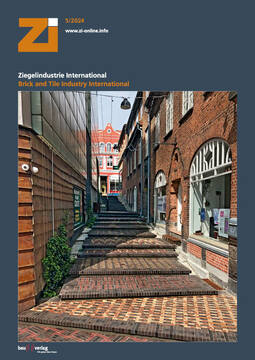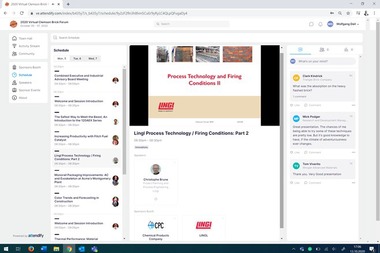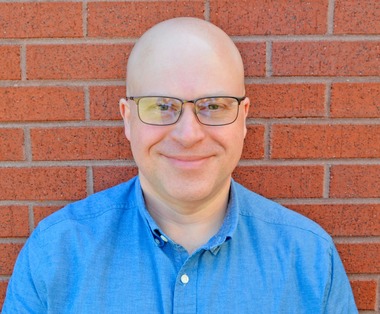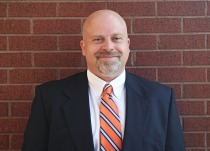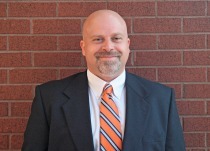Information, connection, steaks - 70th Anniversary of the Clemson Brick Forum
The Clemson Brick Forum has been a fixed date for American brick and tile makers for a long time. This year marks the 70th anniversary. ZI was curious about this long-standing and successful event series. So, editor-in-chief Victor Kapr and John Sanders, director of the National Brick Research Center (NBRC) connected online to talk about the Forum’s history, brickmakers’ needs and the future.
1. History of the Clemson Brick Forum
Who came up with the idea of the Forum?
John Sanders: The first Forum was held at North Carolina State College in 1955. It was founded by Bob Foster who was the General Manager of Brick and Tile Services. This first forum was billed as a short course with the title: “The Tunnel Kiln as a Ceramic Tool”. It wasn’t until the second meeting in 1956 that it received the name “Plant Operator’s Forum” and took place in Clemson, South Carolina, for the first time. Mr. Foster stated once that he was the grandfather of the Forum while Dr Gilbert Robinson, from Clemson University, was the father.
Since 1987, the Brick Forum has been organised by the Center for Engineering Ceramic Manufacturing, founded in 1987 (renamed NBRC in 1999). Which institution was responsible before that?
JS: To the best of my knowledge, there was no organising institution prior to 1987, just two individuals’ initiative. First, Dr Robinson, who started the Ceramic Engineering department at Clemson College (at the time) in 1946 and, in 1971, together with a group of friends, created the precursor of the NBRC to fund research specific to brick manufacturing at a time when most universities in the US were moving away from “Traditional Ceramics” to “Technical Ceramics”. The second person was his wife Barbara, who helped to organize and plan the Forum. This was the case when I first started helping with the Forum around 1990.
It seems Dr Robinson has been quite important for the Forum and the Center.
JS: Yes, he was. I was lucky enough to have been a student of his from 1989 until he passed away in 1996. I learned a lot from him. As did many others, most of whom are retired now. He had a very big impact on the brick industry here in the US. He was also a lot of fun.
His wife Barbara was as instrumental to the Forum as he was, at least in the years that I was involved in the planning. She acted as the Forum Central and sent out all the information, working from her basement. She managed the Forum for a long time.
Who had the idea to include the steak cookout in the program and why?
JS: The steak cookout was added to the Forum in 1959, when it took place for the fourth time. It was held in Clemson, so I have to assume that it was either Dr or Mrs Robinson’s idea.
As to the reason, I can only speculate. Apart from the fact that Dr Robinson enjoyed a good steak quite a bit himself, the reason might be to offer some entertaining form of hospitality. It certainly has been a highlight for many visitors for many years.
2. Topics at Clemson
Have the topics presented at the Brick Forum and occupying the industry’s interest changed since you, John, became program director in 2012?
JS: I have tried to stay true to the original intent of the Forum and keep presentations focused on practical brick production-related issues while still working on talks about future innovations. For example, we will include presentations on best practices, new plants, innovations, wall systems, and environmental health and safety. Dr Robinson also started the tradition of short presentations that he called “Little Things Mean a Lot”. We have evolved this concept into an education resource that we regularly distribute to our manufacturing sponsors.
Attending the Brick Forum last year, I was struck by the fact that brickmakers in the US do not prioritize saving energy and reducing carbon emissions as it is done in Europe.
JS: No, at the moment it’s not a big concern because natural gas is very inexpensive in the US. As well, we do not yet have the carbon emission rules that Europe has. These topics are coming, however and will demand more attention in the future.
This year, therefore, we are trying to lay the groundwork for these topics. I am sure that people are aware that climate change may necessitate regulations and different production processes. However, I do not know if American brickmakers realize how serious it is in Europe. And that conditions in the US will probably follow in this direction. The question is not if, but when. Depending on who wins the next presidential election, it could be a lot sooner. I try to inform the brickmakers that this is the future, and we have to be prepared for it.
What other topics are of concern this year?
JS: Based on the presentations, crystalline silica or quartz exposure will play a role. There are a set of new OSHA (occupational safety and health administration in the US) rules for protecting workers from exposure to these emissions that recently came into force. That will be especially relevant for any industry working with materials with a significant quartz content like all ceramic materials.
3. The US Brick Industry
What challenges is the industry facing at the moment, what challenges are looming on the horizon in the short to medium term?
JS: Concerning the market, I am not the best resource as I am not involved in the business. I typically judge this by the demand for testing services or clay and product properties. We have been extremely busy this year which would imply a high demand. However, that is at odds with the anecdotal stories about production and brick sales I hear. So, people are becoming a little more pessimistic, but are asking for a lot of production and product tests.
There is of course competition with other building materials. A more sustainable focus on house building would help our industry a lot, as long as we educate people about the sustainability of brick, too. Brick has a longer service life and is more resilient than any other exterior cladding material. I think if we can do a good job of educating consumers, brick has a strong future.
A definite challenge is the shortage of workers in the plants. There are not enough people available to do that hard physical labour under from time to time uncomfortable conditions.
The other challenge are environmental regulations – particularly silica at the moment. Regulations related to embodied carbon are looming but are of no concern to brickmakers now.
What about other typical emissions like sulphur and chloride?
JS: We have environmental rules and we’re due for the next round of tightening them. The laws require that every so often the emission caps have to be reviewed. We are a little overdue for that, as there have been some legal issues going on in the background for several years. So we are waiting for the new regulations.
4. Present and Future of the Clemson Brick Forum
What is the main appeal of the Brick Forum to participants?
JS: This has changed a lot over the years. The brick industry is much more open than other ceramic industries that I have worked in. The main appeal of the Forum, as I see it, is the free exchange of information and experiences between manufacturers and the vendors who support them. As I understand it, through the 1970s, the forum had a very limited attendance of just very senior brick production people. In the 1990s more plant production people started to attend and attendance grew and peaked in the early 2000s. Since the great recession, we have seen a return to the original dynamic of the forum with more senior management attendees and fewer plant production attendees. However, due to consolidation tendencies in the industry, the number of senior people is shrinking. Our challenge at the moment is to continue attracting the CEOs and normal factory workers.
What is the problem? Do you need to convince the bosses to pay for their workers’ attendance?
JS: As far as I have heard from the industry, the issue with plant people’s attendance is not connected with money but with staffing questions. Brick factories in the US are operating so lean that they cannot spare the time for production people to be out of the plants.
To enable more attendance from factory staffs we have been playing with the schedule to try to make it fit better for them for a few years. We shortened the program and moved it around during the week to see how it has the least impact on production. That is why the Brick Forum lasts now two days instead of three or four like in former years.
Will the need for information and exchange in the brick industry increase in the future?
JS: I certainly hope so. We work very hard to keep the meeting relevant. We seek input from our manufacturing sponsors as to what information they need to put together a program that meets these needs. Also in my experience, the industry has a demand for information exchange. Brickmakers discuss matters much more freely than in other industries. At the Forum between and even during the talks, you can observe a lot of one-on-one interchanges where they discuss problems. And people are willing to share information with their competitors, too.
What will the 80th Clemson Brick Forum look like?
JS: That is a good question. Things might continue, they might change, as they did in the past. In the 1970s through the 90s, the Forum had a “party” atmosphere in the evenings. Things are more professional now. However, I still hear laments from some of the older attendees about the fun that they used to have. Modern insurance regulations make it harder to have the kind of event that we used to.
To answer your question more specifically, I am pretty sure that the lecture program will probably stay. Somehow, we’ve got to keep the Forum interesting. I am not a professional meeting planner, but I am always open to ideas on how to make things better. I ask the sponsors for their opinions and input, and we do surveys and discussions with them and try to make changes. I wonder, too, how long steak will be the focus of the cookout and when we need to offer more plant-based options. Having a son who’s a vegetarian I understand that more now.
5. Organisers
John, you took over from Denis Brosnan as program and center director in 2012. What’s your background and how did you become program/center director?
JS: When I was in the second year in the ceramic engineering program, I started working for both Dr Brosnan and then Dr Robinson. After finishing my master project on HF emissions and my PhD I left the industry for a few years. I returned in 2000 and worked with Denis until he retired in 2012. I have been director since then. Actually, I am myself now approaching the point where I am starting to think about who comes after me.
How was your first visit at the Brick Forum?
JS: Dr Robinson told me one time he needed help in the evening and that I should show up at a certain time. It was 1990, the event took place outdoors and we didn’t have the sanitation rules we have now. When I got there, he handed me a bucket and a bottle of bleach and said we do not have enough forks for everybody. So, when they come around take the used ones, swirl them in the bleach and then give it to somebody. I was just a student, so I said sure of course.
Who are the people behind the scenes organising the Brick Forum now?
JS: Three people are instrumental to the Forum taking place: Beth Murphy, Jessica Wagner and Gary Parker. Jessica takes care of the technical organisation, the facilities, the food and so on. Beth does the outreach and communication. Gary does all the projection work but he is also the go-to guy whenever you need something to be done or fixed because he can do everything.

